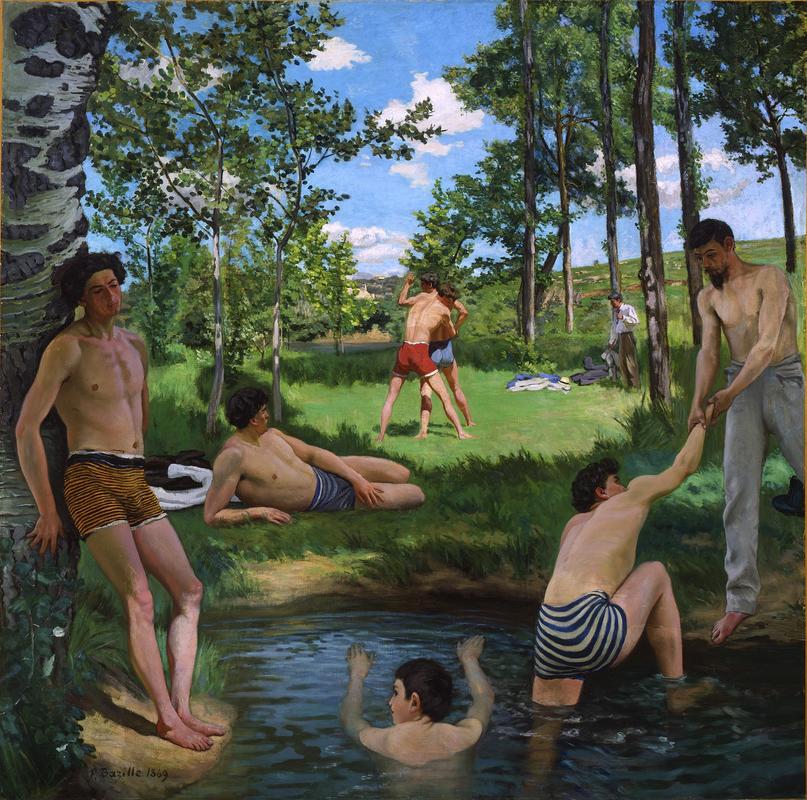More about Summer Scene (Bathers)

Contributor
Frédéric Bazille’s Summer Scene (Bathers) is famous because of how seemingly ordinary it is, while still going against some of the biggest rules established for art at the time.
At first glance, you probably feel like you’ve seen a hundred paintings in your life that look just like this. And you’re not completely wrong. Paintings with people frolicking around half-naked or fully naked in the wilderness is a staple of pretty much every museum on the planet. But if you aren’t an art historian, you probably won’t see some of the decisions that make this painting stand out.
In its composition, it’s mostly a traditional landscape. There’s a foreground, middle ground, and background, and the position of the trees guide the viewer to certain aspects of the scene. But where it differs drastically is in its shape. Landscapes are usually more horizontal, resembling a rectangle, and this is a square. On top of that, scenes in paintings with bathers almost exclusively featured women, and having a scene play out with all men was something that simply wasn’t done at the time. Art stans of the period must have been confused. How dare Bazille break the rules like this? Others were probably impressed, as Bazille broke the rules, sure, but in a clever way.
What’s also interesting is how this painting represents the time it was created. Since 1835 in France, bathing in the nude had been outlawed. Men could still do so if they covered up certain parts, but women were forced to do it privately. So by following the rules of society, in which only men were actually allowed to skinny dip in the woods, Bazille essentially breaks the rules of landscape painting and the subjects that normally inhabit it.
Some of the subjects of the painting mimic the physical positions of male figures painted by prominent Renaissance painters, notably Andrea Mantegna and Sebastiano del Piombo. Referencing the work of past famous painters shows a connection Bazille had with their work, and was a way to pay back the inspiration that they gave him.
This painting is considered Bazille’s last masterpiece, as he died shortly after while fighting in the Franco-Prussian war. When you take that into consideration, especially when you couple it with another late work The Family Reunion — where he immortalized his family in their natural, unedited habitat— it represents a love letter, an celebration of his roots and a farewell to those who helped shape him.
Sources
- The Art Story. “Frédéric Bazille Artworks”. Accessed September 21, 2021. https://www.theartstory.org/artist/bazille-frederic/artworks/
- Kennicott, Philip. “Young, gifted, and cut down by a stupid war”. The Washington Post. April 6, 2017. https://www.washingtonpost.com/entertainment/museums/young-gifted-and-c…
- Schjeldahl, Peter. “Frédéric Bazille’s Short Career, Reconsidered”. The New Yorker. April 10, 2017. https://www.newyorker.com/magazine/2017/04/17/frederic-bazilles-short-c…
Featured Content
Here is what Wikipedia says about Scène d'été
Scène d'été, Summer Scene, or The Bathers is an oil-on-canvas painting by the French artist Frédéric Bazille from 1869. It is now in the Fogg Art Museum in Cambridge, Massachusetts. The Impressionist painting depicts young men dressed in swimsuits having a leisurely day along the banks of the Lez river near Montpellier. Bazille composed the painting by first drawing the human figures in his Paris studio and then transporting the drawings to the outdoor setting. Like his earlier painting Réunion de famille (1867), Scène d'été captured friends and family members in the outdoors. Scène d'été was exhibited at the Paris Salon in 1870.
It may have been an inspiration for Thomas Eakins' The Swimming Hole (1885), as Eakins was in Paris in 1870 and could have seen Bazille's painting.
Check out the full Wikipedia article about Scène d'été












